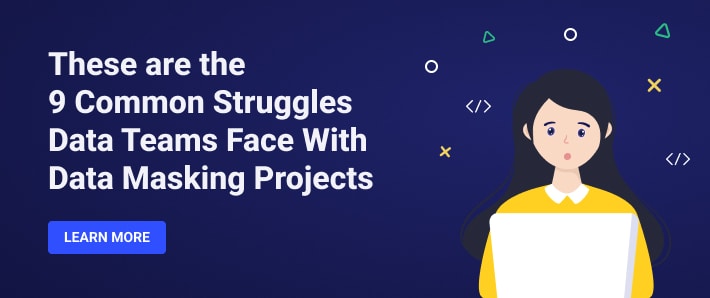Businesses must ensure that private data gets utilized as little as possible in light of rising cyber dangers and data privacy legislation.
As a result, data security has become a prime focus for many businesses. As a result, data masking has become a necessary approach for many firms to protect sensitive data.
Data masking allows businesses to test their systems using data as near to real data as possible while limiting private data.
This article will discuss the following:
This is part of our comprehensive data masking guide.
What Is Data Masking?
Data masking is the term used for creating a fake but realistic representation of a company’s sensitive information or data set. When actual data isn’t required, such as in user training, sales demos, or software testing, the purpose is to safeguard sensitive information while offering an ad-hoc, functioning replacement.
The top data masking tools and methods alter the data’s values while maintaining the same format. The goal is to produce a version that cannot be decoded or reverse engineered to provide access control and maximal data protection.
Essentially, a data masking solution provides the following benefits:
- Anonymization of data to comply with privacy and data protection regulations.
- Reduced sensitive data exposure risk, to meet security objectives.
- The above two items while still being able to provide value from the data, for example data analytics or building machine learning models.
Types of Data Masking Tools
Depending on your use case, you can choose from various data masking options.
Static Data Masking
Static data masking gets most commonly used on a production database backup. SDM alters data to make it appear accurate to develop, test, and train accurately, all without revealing facts.
Deterministic Data Masking
Column data gets replaced with the same value in deterministic data masking. For example, if your databases have a first name column that spans numerous tables, there could be many tables with the same first name. The masking will give you the same result every time you run it. This is often done by hashing algorithms.
Statistical Data Obfuscation
You can use statistical data obscuration techniques to hide different statistical information in production data. Differential privacy is one of the many aspects of data obfuscation tools for SQL servers. It allows you to exchange information about patterns in a data set without revealing information about the individuals in the data set.
Dynamic Data Masking
Dynamic Data Masking happens dynamically at run time and streams data directly from a production system so that masked data will not need to get saved in another database. It is primarily used for processing role-based security for applications, such as processing customer inquiries and handling medical records. Thus, DDM applies to read-only scenarios to prevent writing the masked data back to the production system.
On-the-fly data masking happens when data is transferred from one environment to another, such as tests or development. Data masking on the fly is appropriate for organizations that:
- Have a lot of data consumers with different requirements
- Have data that changes often
Learn more in our dedicated dynamic data masking guide.
Dynamic Data Masking Tools
Manually copying data and deleting or anonymizing information might slow down analysis and reduce data utility. It is a good thing there are Dynamic Data Masking technologies to help with this. To learn more about how Satori provides dynamic data masking, regardless of the data store used, visit our dynamic data masking capability page.
Data Masking Best Practices
If you are ready to start masking data, here are some tips for data masking to follow.
Determine Sensitive Information
Masking does not get required for any of a company’s data elements. Instead, in both production and non-production situations, properly identify any existing sensitive data. This option could take a long time, depending on the intricacy of the data and the organizational structure.
Define Your Data Masking Technique Stack
Because data differs so much, large enterprises can’t employ a single masking tool across the board. Furthermore, the method you use may need you to adhere to specific internal security regulations or fulfill budgetary constraints. You may need to refine your masking approach in some circumstances.
So, consider all of these important criteria when selecting the proper collection of strategies. Keep them in sync to ensure that the same data type uses the same referential integrity technique.
Make Sure Your Data Masking Procedures are Secure
Masking techniques and data are just as important as sensitive data. A lookup file, for example, can be used in the substitution strategy. If this lookup file falls into the wrong hands, you may reveal the original data set.
Only authorized people should access the masking algorithms; thus, organizations should develop the necessary guidelines.
Make the Masking Process Repeatable
Changes to an organization, a specific project, or a product can cause data to alter over time. Whenever possible, avoid starting from the beginning. Instead, make masking a repeatable, simple, and automatic procedure so that you may use it whenever sensitive data changes.
Define a Data Masking Procedure that works from Beginning to End
An end-to-end procedure must be in place for organizations, which includes:
- Detecting and identifying sensitive data.
- Using a data masking approach that is appropriate.
- Auditing regularly to ensure data masking is working properly.
Summary
Many companies rely on data masking to protect sensitive information by hiding its authenticity.
Organizations that use data masking to secure sensitive information require a comprehensive security solution. Even if data is hidden, you must safeguard infrastructure and data sources such as databases against more sophisticated cyberattacks.
Satori, The DataSecOps platform, provides dynamic data masking, whether your data is in databases, data warehouses, or data lakes. Learn about our other capabilities here:
- Fine-Grained Access Control
- Decentralized Data Access Workflows
- Data Access Auditing & Monitoring
- Continuous Data Discovery & Classification
To learn more about Satori, go here or book a demo with one of our experts.




